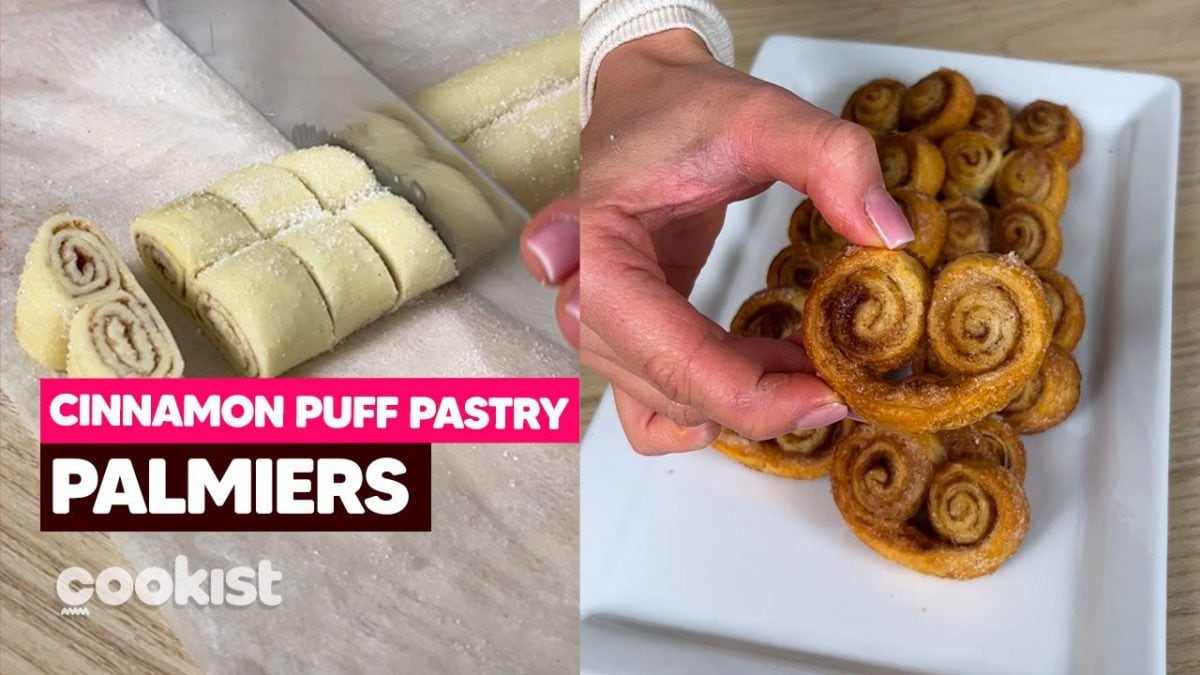
Sometimes, life calls for a sweet treat that doesn't require hours in the kitchen or a complicated recipe book. Enter Cinnamon Palmiers, also known as puff pastry elephant ears. These little gems are the epitome of "easy treats," offering a symphony of crispness and chew that will leave you wanting more. Each bite is a delicious explosion of flavor and texture, making palmiers the ideal sweet tooth satisfier. Forget complicated ingredients or intimidating techniques. All you need are three staples: store-bought puff pastry, ground cinnamon, and sugar. To make it is easy too. Simply roll out the puff pastry, coat it in the fragrant cinnamon sugar mixture, and fold it into layers to create tasty swirls. So ditch the complicated dessert recipes, embrace the magic of puff pastry, and embark on a journey to create these irresistible treats.
What are Cinnamon Palmiers?
Cinnamon palmiers, also known as puff pastry elephant ears, are characterized by flaky, golden layers of puff pastry, generously dusted with a warm cinnamon sugar mixture, and baked to crispy perfection. Each bite is a combination of textures—the satisfying snap of the caramelized sugar and the chew of the flaky pastry—all infused with the sweet warmth of cinnamon.
Palmiers have garnered a variety of nicknames depending on location. In Latin America, they're known as "orejitas" (little ears), while Colombia celebrates them as "mariposas" (butterflies). In Spain, they're "palmeritas," and Germany calls them "Schweineohren" (pig's ears). Enjoy them warm or at room temperature, alongside coffee, tea, or even as part of a brunch spread. Drizzle them with a light glaze for extra decadence, or sprinkle with chopped nuts for a textural twist.
Tips
- Puff pastry is the main component of this recipe, so make sure it's properly thawed in the refrigerator for at least overnight. Don't be tempted to microwave it, as this can lead to uneven puffing and a less flaky texture.
- Once rolled out and coated in cinnamon sugar, chill the dough again for at least 30 minutes. This allows the flavors to meld and the butter in the puff pastry to firm up, resulting in crispier layers.
- A dull knife can tear the dough. Use a sharp knife to ensure clean, even cuts for uniform baking.
- Don't overcrowd the baking sheet. As palmiers bake, they expand. Leave enough space between each pastry to ensure even browning and prevent them from sticking together.
- Don't be shy with the cinnamon sugar mixture! A generous coating ensures every bite is bursting with flavor.
- Keep an eye on your palmiers during baking. They should be golden brown and caramelized around the edges, but not burnt.
- Since puff pastry relies on steam to rise, preheating your oven is essential. A hot oven ensures the pastry puffs properly, resulting in those flaky layers.
- While cinnamon sugar is the classic, explore other flavor combinations! A sprinkle of nutmeg with the cinnamon adds warmth, or a drizzle of chocolate after baking creates a decadent twist. Chopped nuts like pecans or almonds add a delicious textural contrast.
Palmiers Vs. Croissants
Palmiers are flat, heart-shaped pastries with a crispy, caramelized exterior, created by folding puff pastry with sugar and then slicing and baking. In contrast, croissants are crescent-shaped pastries known for their flaky, buttery layers, achieved through laminating dough with butter and then rolling it out. The key difference lies in the folding technique and the absence of sugar in the croissant dough, which gives palmiers a sweeter, crunchier profile compared to the softer, more bread-like texture of croissants.
What Are They Called In Other Countries?
They have various names worldwide, including elephant ears, palmeritas (Spain), orejitas (little ears) in Latin America, and butterflies in Colombia.
What Kind Of Cinnamon Should I Use?
Ground cinnamon is ideal. Experiment with different varieties like Saigon cinnamon for a deeper flavor.
How Do I Keep Palmiers From Unraveling?
To keep the palmiers from unraveling, make sure to chill the rolled pastry in the freezer for about 5 minutes before slicing. This step firms up the dough, helping the palmiers maintain their shape during baking. Additionally, brushing the dough with a little water before rolling can help the layers stick together.
Can I Freeze Palmiers?
Yes, but freezing can affect their texture. They'll last up to 2 months but might be slightly less crisp when thawed.
How Do I Reheat Palmiers?
You can reheat them in a low oven (175°C/350°F) for 5 – 7 minutes or use a toaster oven for a single serving.
What Are Some Other Flavor Variations?
You can explore different spice combinations like nutmeg with cinnamon or a chocolate drizzle after baking. Chopped nuts like pecans or almonds add a nice textural contrast.
Can I Make Savory Palmiers?
Yes! Use herbs and cheese in the filling before rolling and baking.
How to Store Cinnamon Palmiers
Store leftover palmiers in an airtight container at room temperature for up to 2 days. For longer storage, place your palmiers in an airtight container and store them in the refrigerator for up to 1 week.
Ingredients
How To Make Cinnamon Palmiers
;Resize,width=712;)
Gently unfold the thawed puff pastry sheet on a piece of baking sheet. Brush the puff pastry lightly with water. Sprinkle a generous amount of sugar and cinnamon all over the puff pastry surface.
Gently unfold the thawed puff pastry sheet on a piece of baking sheet. Brush the puff pastry lightly with water. Sprinkle a generous amount of sugar and cinnamon all over the puff pastry surface.
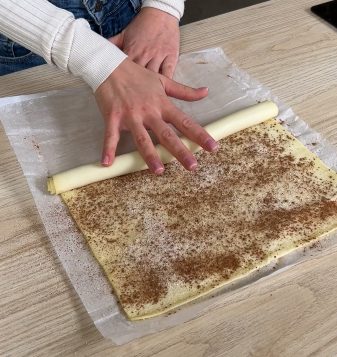;Resize,width=712;)
Starting from one long edge, gently roll the puff pastry dough towards the center.
Starting from one long edge, gently roll the puff pastry dough towards the center.
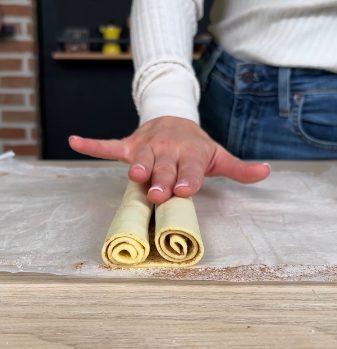;Resize,width=712;)
Repeat with the opposite side, creating a double roll that meets in the middle.
Repeat with the opposite side, creating a double roll that meets in the middle.
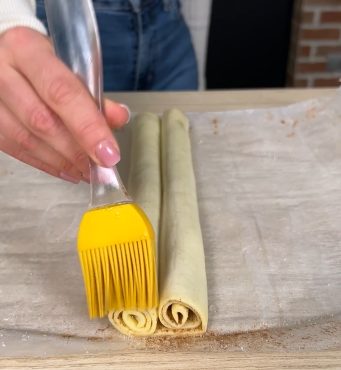;Resize,width=712;)
Brush the double-rolled pastry with water.
Brush the double-rolled pastry with water.
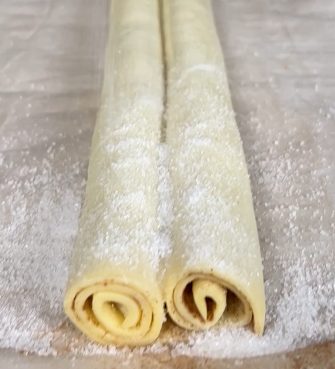;Resize,width=712;)
Sprinkle with more sugar, then loosely wrap the rolled dough in the baking sheet and pop it in the freezer for 5 minutes.
Sprinkle with more sugar, then loosely wrap the rolled dough in the baking sheet and pop it in the freezer for 5 minutes.
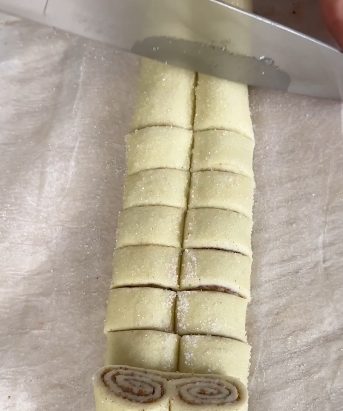;Resize,width=712;)
Preheat the oven to 200°C/400°F. Use a sharp knife to cut the chilled dough into medium-sized slices, approximately ½ inch thick.
Preheat the oven to 200°C/400°F. Use a sharp knife to cut the chilled dough into medium-sized slices, approximately ½ inch thick.
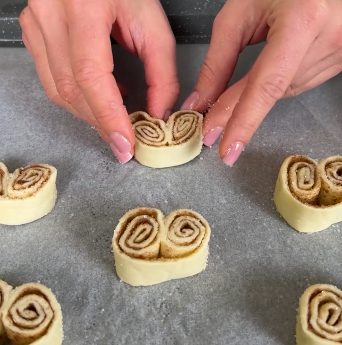;Resize,width=712;)
Arrange the slices on a baking sheet, leaving space between them for even baking.
Arrange the slices on a baking sheet, leaving space between them for even baking.
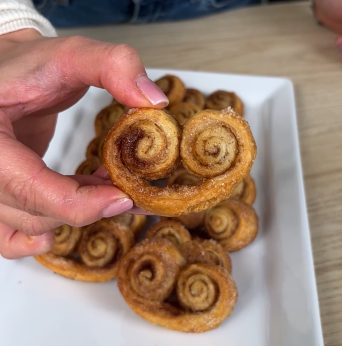;Resize,width=712;)
Bake the palmiers for 15 minutes, or until they're golden brown and puffed. Once baked, let the palmiers cool slightly on the baking sheet before serving them.
Bake the palmiers for 15 minutes, or until they're golden brown and puffed. Once baked, let the palmiers cool slightly on the baking sheet before serving them.

;Resize,width=767;)
